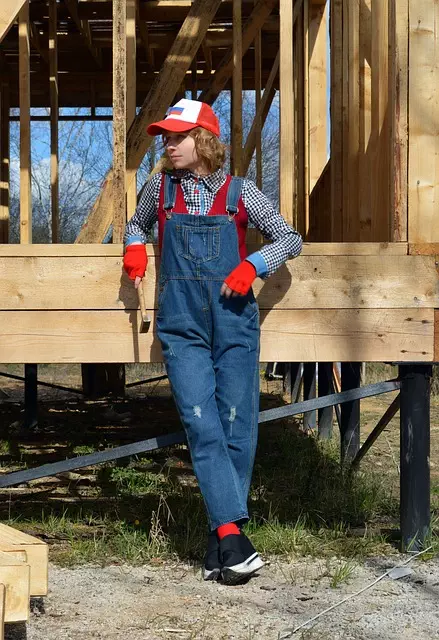Structural Stem Wall Reinforcement is crucial for Residential Foundation Repair, addressing weaknesses caused by settlement, poor construction, or environmental factors. Identifying stem wall issues early through regular inspections prevents major damage. Modern reinforcement techniques, using materials like high-strength steels and FRPs, enhance stability against lateral forces. The meticulous process involves excavation, installation of rods/mesh, and concrete backfill for durable repairs. Regular maintenance, including moisture management and protection, prolongs stem wall integrity, reducing future Residential Foundation Repair costs.
“Discover the critical role structural stem walls play in residential foundation repair. This comprehensive guide explores the basics of stem wall reinforcement, delving into its understanding, benefits, and various techniques. Learn about identifying weaknesses, common failure causes, and modern reinforcement materials. From bracing to shoring, we break down an effective step-by-step process. Additionally, explore long-term maintenance strategies to ensure longevity. Strengthen your knowledge of stem wall reinforcement for optimal residential foundation repair.”
Understanding Structural Stem Wall Reinforcement: A Basic Overview

Structural Stem Wall Reinforcement is a critical aspect of residential foundation repair, focusing on enhancing the load-bearing capacity and stability of stem walls. These walls, often constructed using concrete or masonry, form the base of a structure’s foundation, transferring vertical loads from the superstructure to the soil below. Over time, various factors like settlement, ground shifts, or poor initial construction can compromise their integrity.
Reinforcement techniques involve adding structural elements such as steel braces, tie rods, or mesh to strengthen the stem walls. This process not only improves the wall’s ability to resist lateral forces but also helps prevent further damage and ensures the long-term stability of the entire foundation system. Understanding these reinforcement methods is essential for homeowners and professionals in the residential foundation repair industry alike.
The Role of Stem Walls in Residential Foundation Repair

Stem walls play a crucial role in residential foundation repair, acting as structural supports that stabilize the entire foundation system. In many homes, particularly those built on uneven terrain or in areas prone to seismic activity, stem walls are an essential component of the foundation’s strength and durability. They help distribute the weight of the structure evenly, preventing cracks and settling issues that often arise from weak or inadequate foundations.
When a residential foundation shows signs of damage, reinforcing the stem walls is often a top priority. This process involves adding structural support to strengthen the walls, ensuring they can withstand environmental pressures and prevent further deterioration. By bolstering these critical components, homeowners can significantly improve the overall stability and longevity of their properties, thereby enhancing the effectiveness of residential foundation repair efforts.
Identifying Weaknesses and Signs of Damage

Identifying weaknesses and signs of damage in stem walls is crucial for ensuring the stability and integrity of a residential foundation repair project. Over time, soil movement, settling, or exposure to harsh weather conditions can weaken these structural elements, leading to cracks, bulges, or uneven surfaces. Regular visual inspections are essential to detect any signs of distress, such as visible cracks, shifts in wall alignment, or gaps between the wall and surrounding structures.
Homeowners should also be vigilant for more subtle indications like doors or windows that stick, floor unevenesses, or changing patterns in plumbing lines, which could all point to underlying stem wall issues that require professional attention. Early detection allows for more effective and cost-efficient residential foundation repair solutions before damage progresses.
Common Causes of Stem Wall Failure

Stem wall failure is a common issue in residential foundation repair, often stemming from several underlying causes. One primary factor is inadequate initial construction, where poor-quality materials or improper techniques lead to structural weaknesses over time. This includes issues like improper grading, which can cause water accumulation at the base of the stem wall, leading to erosion and eventual collapse.
Another significant contributor is environmental factors, such as seismic activity, high wind loads, and excessive soil moisture content. These external forces can exert immense pressure on stem walls, causing cracks, bulges, or even complete failure, especially if the structure was not designed or reinforced to withstand such stresses. Understanding these common causes is crucial for homeowners and builders alike to implement effective solutions for residential foundation repair and prevent future structural damage.
Techniques for Effective Reinforcement: Bracing, Shoring, and More

When it comes to structural stem wall reinforcement for residential foundation repair, several effective techniques can be employed to ensure stability and longevity. Bracing involves using wooden or metal supports to hold the wall in place, preventing further shifting or collapse. This method is particularly useful for walls showing signs of leaning or bowing. By installing vertical braces at regular intervals, horizontal cross-braces, and corner brackets, the structural integrity of the stem wall is significantly enhanced.
Shoring is another critical process that involves using temporary supports to hold the wall upright during reinforcement work. This technique is often used when there’s a need for extensive repairs or when the existing walls are severely damaged. Shoring systems can include hydraulic jacks, wooden planks, and steel beams, which are strategically placed to distribute the weight evenly and support the stem wall from above. Proper shoring ensures that the foundation can withstand lateral forces, such as wind and seismic activities, making it a vital step in residential foundation repair.
Materials Used in Modern Stem Wall Reinforcement Solutions

In modern residential foundation repair, stem wall reinforcement solutions have evolved significantly, offering advanced materials that enhance structural integrity and longevity. Among the prevalent choices are high-strength steels, such as carbon steel and various alloys, known for their exceptional strength-to-weight ratio. These metals are often used in the form of welded mesh or threaded rod cages, providing robust support for the stem walls.
Additionally, fiber-reinforced polymers (FRP) have gained popularity due to their lightweight nature, corrosion resistance, and excellent mechanical properties. FRPs can be molded into complex shapes, making them versatile for custom reinforcement applications. This material choice is particularly advantageous in environments where traditional metals may face corrosion issues, ensuring long-term stability and durability for the foundation repair process.
Step-by-Step Process of Implementing Reinforcements

Implementing structural stem wall reinforcements for residential foundation repair involves a meticulous, step-by-step process designed to enhance stability and longevity. It begins with a thorough inspection, identifying existing vulnerabilities and determining the extent of reinforcement required. Next, professionals excavate around the stem wall, creating access for installing steel rods or mesh, which are critical components in butting against the existing structure.
The chosen reinforcement method is then carefully placed within the exposed cavity. This could involve wrapping wire mesh around the wall or driving steel rods into the ground, connecting them to the stem wall. Once positioned, a concrete backfill strengthens the entire assembly, securing the reinforcements firmly in place. This step-by-step approach guarantees that residential foundation repair is both effective and durable, addressing potential issues for years to come.
Long-Term Maintenance and Prevention Strategies

Maintaining structural stem wall integrity is a long-term commitment, crucial for preventing costly residential foundation repair. Regular inspection is key; identifying potential issues early can significantly reduce the need for extensive repairs later. Strategies to safeguard against deterioration include moisture management, as water damage is a leading cause of foundation problems. This involves proper drainage around the home, sealing cracks, and addressing any signs of leaks or humidity.
Additionally, reinforcing stem walls with modern techniques offers durability and peace of mind. Mesh reinforcements, for instance, provide extra stability by connecting concrete blocks or bricks, preventing cracking and shifting over time. Regular cleaning and repainting can also protect against environmental factors like rust and corrosion, ensuring the longevity of your stem wall system and safeguarding against the need for frequent residential foundation repair services.
